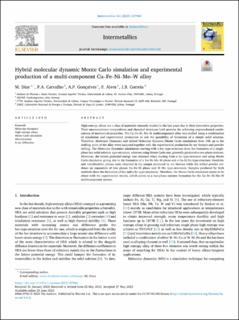| dc.contributor.author | Dias, M. | |
| dc.contributor.author | Almeida Carvalho, Patricia | |
| dc.contributor.author | Gonçalves, A.P. | |
| dc.contributor.author | Alves, E. | |
| dc.contributor.author | Correia, J.B. | |
| dc.date.accessioned | 2024-04-10T12:56:11Z | |
| dc.date.available | 2024-04-10T12:56:11Z | |
| dc.date.created | 2023-07-12T11:30:36Z | |
| dc.date.issued | 2023 | |
| dc.identifier.citation | Intermetallics (Barking). 2023, 161: 107960. | en_US |
| dc.identifier.issn | 0966-9795 | |
| dc.identifier.uri | https://hdl.handle.net/11250/3125843 | |
| dc.description.abstract | High-entropy alloys are a class of materials intensely studied in the last years due to their innovative properties. Their unconventional compositions and chemical structures hold promise for achieving unprecedented combinations of mechanical properties. The Cu–Fe–Ni–Mo–W multicomponent alloy was studied using a combination of simulation and experimental production to test the possibility of formation of a simple solid solution. Therefore, Molecular Dynamics and hybrid Molecular Dynamic/Monte Carlo simulations from 10K up to the melting point of the alloy were analyzed together with the experimental production by arc furnace and powder milling. The Molecular Dynamics simulations starting with a bcc type-structure show the formation of a single-phase bcc solid solution type-structure, whereas using Monte Carlo one, generally produced a two-phase mixture. Moreover, the lowest potential energy was obtained when starting from a fcc type-structure and using Monte Carlo simulation giving rise to the formation of a bcc Fe–Mo–W phase and a Cu–Ni fcc type-structure. Dendritic and interdendritic phases were observed in the sample produced by arc furnace while the milled powder evidence an separation of two phases Cu–Fe–Ni phase and W–Mo type-structures. Samples produced by both methods show the formation of bcc and a fcc type-structures. Therefore, the Monte Carlo simulation seems to be closer with the experimental results, which points to a two-phase mixture formation for the Cu–Fe–Ni–Mo–W multicomponent system. | en_US |
| dc.language.iso | eng | en_US |
| dc.publisher | Elsevier | en_US |
| dc.rights | Attribution-NonCommercial-NoDerivatives 4.0 Internasjonal | * |
| dc.rights.uri | http://creativecommons.org/licenses/by-nc-nd/4.0/deed.no | * |
| dc.title | Hybrid molecular dynamic Monte Carlo simulation and experimental production of a multi-component Cu–Fe–Ni–Mo–W alloy | en_US |
| dc.title.alternative | Hybrid molecular dynamic Monte Carlo simulation and experimental production of a multi-component Cu–Fe–Ni–Mo–W alloy | en_US |
| dc.type | Peer reviewed | en_US |
| dc.type | Journal article | en_US |
| dc.description.version | publishedVersion | en_US |
| dc.rights.holder | © 2023 The Authors. Published by Elsevier. | en_US |
| dc.source.pagenumber | 10 | en_US |
| dc.source.volume | 161 | en_US |
| dc.source.journal | Intermetallics (Barking) | en_US |
| dc.identifier.doi | 10.1016/j.intermet.2023.107960 | |
| dc.identifier.cristin | 2162091 | |
| dc.relation.project | Norges forskningsråd: 280545 | en_US |
| dc.relation.project | Norges forskningsråd: 275752 | en_US |
| dc.source.articlenumber | 107960 | en_US |
| cristin.ispublished | true | |
| cristin.fulltext | original | |
| cristin.qualitycode | 1 | |

